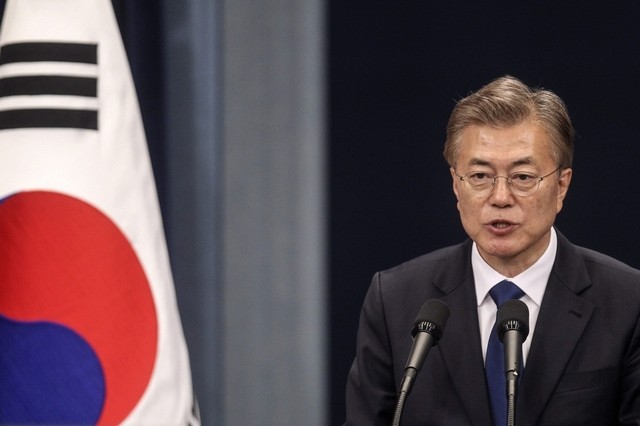Political taxonomy is just as muddled right now as electoral trends.
In South Korea, a progressive politician with socially conservative views won Tuesday’s presidential election. France’s new president-elect is a banker who served in the outgoing socialist government and describes himself as a “radical centrist”.
In Britain’s continuing election campaign, the governing centre-right Conservative Party is successfully co-opting the far-right UK Independence Party’s issues, some of its language and a lot of its fervour. India’s prime minister, who came to office on a Hindu nationalist free-market platform, has started to hew left as a class warrior. In the US election, a billionaire with no discernible religious sympathies was successfully able to present himself as a champion of the working classes and of conservative Christians.
In Spain, shortly before the US presidential election, the conservative party’s prime minister was returned to office with parliamentary assistance from the socialists, but the latter are under pressure from the nationalist ultra-left Podemos. Just to add to the chaos, Podemos was the only Spanish political party to express doubts about Emannuel Macron, who defeated his far-right challenger Marine Le Pen. Their doubts revealed the uniting of the extreme ends of the political spectrum, against centrist forces and globalisation.
With right, left and centre of the spectrum increasingly muddled, how do you classify these politicians, their parties, broad ideological fraternities and the people they represent? What do you call politicians who are fairly left-wing but unwilling to unite with centrists against the far-right? Might they be called “Light-ist”? Opportunists? Pragmatists? Conversely, what do you call far right politicians who support the welfare state?
The labelling headache is compounded now that politicians increasingly claim not to lead political parties but “movements”. Donald Trump, an atypical candidate of the US Republican Party, repeatedly says he led a movement to victory. Ms Le Pen and her supporters claim the same word for the 11 million people who voted for her on Sunday. The Front National, they say, is a movement that measures its progress over decades. Even Mr Macron has said his victorious, now-renamed, upstart outfit is a movement rather than a new political party.
The taxonomic tangle gets worse when it comes to voters.
In many parts of the world, the electorate is no longer precisely right or left. Those who turned out enthusiastically for South Korea’s new president Moon Jae-in may be a case in point. They were overwhelmingly young and passionate about economic revival and fighting corruption, something they call “dirt spoon vs gold spoon” policies. This issue seems to link Mr Moon’s supporters with electorates around the world. They were also progressive in their pacifist inclinations, expressing support for his stated desire for a dialogue with North Korea.
Interestingly, however, they were at ease with Mr Moon’s social conservatism, which may indicate the extent to which these young South Koreans remain rooted in their own culture and norms, rather than straining towards a fast-liberalising, homogeneous global groupthink. And they probably approve of Mr Moon’s notion of South Korean self-reliance — a quasi-nationalist foreign policy — because he has been upfront about the idea that Seoul should “learn to say no” to Washington.
A clutch of categories are hurriedly being cobbled together in an attempt to bring some order to the chaos of the new political divides that straddle right and left even as they skitter off in other directions too. These are as follows: nationalists versus globalists. Tribals versus cosmopolitans. Somewhere versus anywhere. Populists versus elites. Losers versus winners. Rural versus urban.
Broadly, each of these categories indicates the same basic difference in mindsets. Voters who believe that they share one planet and have an interdependent future versus those that resent the idea. This may sound promising considering Ms Le Pen recently cast the French presidential election as a contest between globalists and patriots. Mr Trump has oft thundered about the “forgotten people” and British prime minister Theresa May invokes the problems of those “left behind”. But there are problems with these taxonomic definitions. First, they don’t cover the globe, being truer for the west than for the east. Rural vs urban doesn’t really apply to the political reality of countries such as India, where Mr Modi’s governing Bharatiya Janata Party has long been an urban success story. Second, none of these definitions properly explains the motivations or even the situation of the western voter who opted for Mr Trump and Ms Le Pen.
Their supporters were neither mostly rural nor always left-behind. An early estimate of Mr Trump’s supporters put their income at $72,000 (Dh264,000) a year, which is comfortably above the national average.
Rural western France did not exactly thrill to the Front National’s siren call. And parts of urban America did embrace Mr Trump. Does this American president then embody the hopes of the “heartland”, of “Real America”, or of somewhere vaguely located in Middle America, somewhat rural, and somewhat de-industrialised, somewhat envious and anxious?
Is Ms Le Pen’s support deeply held in so-called La France profonde, a rural region of deep and authentic Frenchness? Or does it reflect the angst of la France peripherique, “peripheral France”, a phrase that became popular during the election period? None of the above is probably the right answer. But then there isn’t a right answer just yet.


